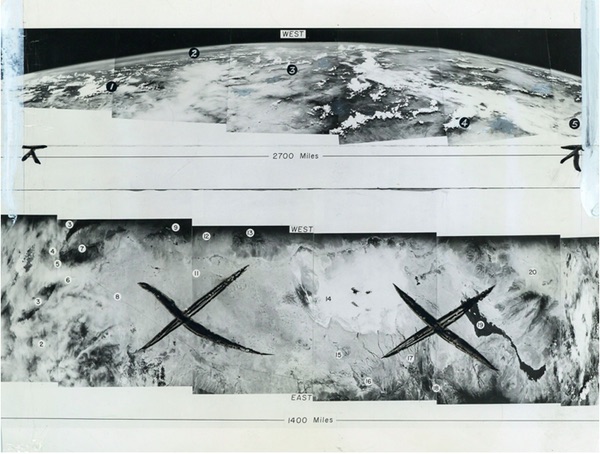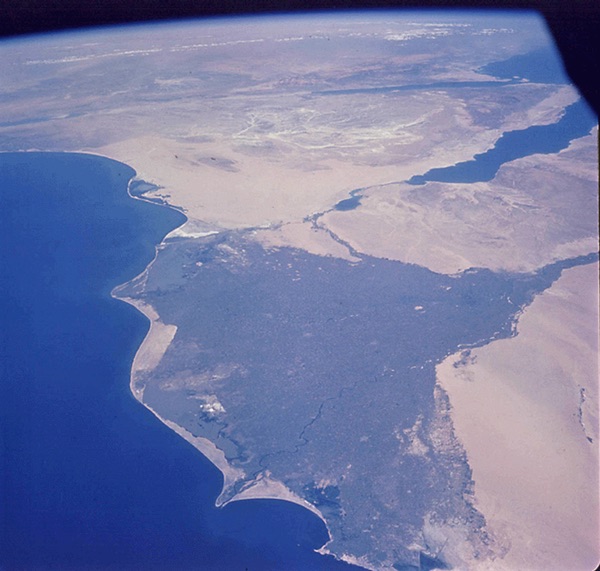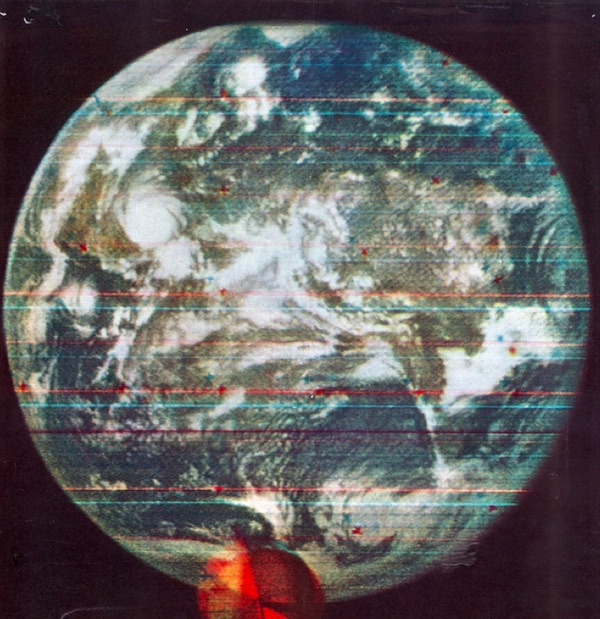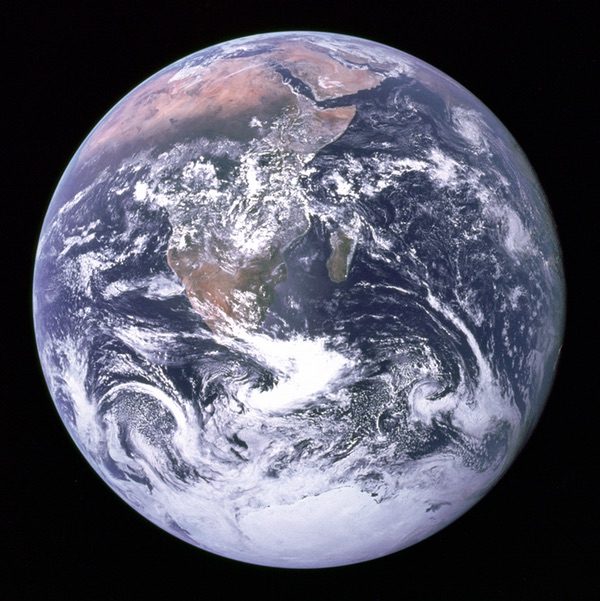
On seeing the Earth for the first timeby Christopher Potter
|
| To see more of the Earth’s curving horizon, clearly a higher vantage point would be required. |
From the late eighteenth century, hot-air balloonists first saw the Earth from a perspective that was not part of the Earth itself, not from the top of a mountain or a cathedral spire, but from the perspective of another medium. In 1935, as part of an expedition sponsored by the National Geographic Society, Captain A. W. Stephens and Captain O. A. Andrews from the US Army Air Corps ascended to a record-breaking altitude of 22 kilometers in a gondola attached to a helium-filled balloon, higher than any commercial jet is permitted to fly even today. A photograph taken from the balloon as it sailed high above the Black Hills of South Dakota captured in a panorama, stretching 530 kilometers, the curvature of the Earth for the first time. At last, here was visual rather than merely intellectual proof that we live on a sphere.
To see more of the Earth’s curving horizon, clearly a higher vantage point would be required. To rise higher would require not planes but rockets.
At the end of World War II, American forces captured the German engineer Wernher von Braun, the designer of the world’s first ballistic missile. His 14-meter-tall, 13-ton rocket known as the V-2 had not affected the outcome of the war as Hitler had hoped, but it was now to play a central role in the history of space. On April 16, 1946, von Braun and his German colleagues—soon to become American citizens—rebuilt the V-2 on American soil. More than 60 V-2s, modified to carry various kinds of scientific equipment, would be launched from a site in New Mexico over the next few years. Clyde T. Halliday, a photography specialist, was responsible for the difficult task of working out how to attach cameras to the rockets that would survive the rockets’ impact. Halliday got his best set of aerial photos from a V-2 flight of 1948 taken at an altitude of 105 kilometers. Out of these images, and another set of photographs taken from the flight of an Aerobee rocket that took place an hour later, Halliday patched together a 4,345-kilometer mile-wide panorama of the Earth, a tenth of the Earth’s circumference.
 Clyde T. Halliday’s composite image of July 1948 showing a tenth of the Earth’s circumference. |
In 1958, America’s newly formed space agency, NASA, announced the creation of Project Mercury, a series of one-manned orbital flights. From the start, NASA grandees were against the astronauts taking what they sneeringly called “tourist” photographs of the Earth. John Glenn, the first American to orbit the Earth, had to insist on taking his own camera on board. He bought it at a local drugstore for $19.95. Not surprisingly, the photographs he took were worthless.
The situation improved when Richard Underwood was appointed to head up a small advisory group responsible for photography. After he had graduated from university, Underwood had joined the US Army Corps of Engineers as part of an Army project to study the Earth’s geological features seen from the air. It was said that he could identify any region of the Earth from an aerial photograph.
Some remarkable photographs of the Earth seen from orbit were taken during the Gemini program that followed Mercury. In June 1965, during the second of the flights, Ed White became the first American to walk in space. He managed to take a few high-quality photographs of the Earth from his unique vantage point. Underwood pointed out to his still-skeptical NASA bosses that they were looking at the Earth as no human being had ever seen it before.
 Taken in 1965 during the second manned Gemini flight, 135 miles over the Nile Delta. |
| “Well, I don’t give a damn why you did it,” Karth cut in, “but me and 200 million other Americans thank you.” |
On August 10, 1966, Lunar Orbiter 1 became the first American spacecraft to orbit the Moon. It was just one of many missions undertaken to identify a future landing place for the upcoming Apollo missions. Lunar Orbiter 1 had only enough power to take 211 pictures in medium resolution, but Underwood hoped that at least one of the photographs would be not of the Moon but of the Earth. There were arguments right up to the last minute. A decision had not been reached even when the craft was in lunar orbit, Underwood being told that it was a waste of film, that such a photograph would have no scientific value, and so on. In the end a senior figure at the meeting, the vice president of Boeing, said, “To hell with it. It is a public service. It might be tremendous.”
Word spread around the center that the picture had been taken. Senator Joseph Karth, chairman of the congressional committee on space sciences, was soon on the phone to Lee Scherer, NASA’s program manager: “What’s all this about you taking a picture of the Earth?” Scherer was defensive, and started to reel off any reasons that popped into his head that seemed to justify the taking of the photograph: “Well, I don’t give a damn why you did it,” Karth cut in, “but me and 200 million other Americans thank you.”
When the photographs from the mission were released to the public, those of the Moon attracted more attention. The subsequent official report summarizing all five Orbiter missions did not mention the photograph of the Earth at all. The significance of the image was missed. Though it was in black and white, and much of the Earth in shadow, here for the first time in human history was an image of the whole Earth.
 The first photograph of the Earth seen from the Moon. Taken by Lunar Orbiter 1 on August 23, 1966. |
In early July the following year, the DODGE (Department of Defense Gravitational Experiment) military satellite was launched. The director of DODGE predicted an educational use for satellites; no one at the time foresaw the power of the satellite to change life on Earth utterly. Curiously, the evidence was already there for anyone to see. Just a few days earlier, the BBC had broadcast a live TV show called Our World, conceived by BBC executive Aubrey Singer, joining much of the world together for the first time by airwaves. Artists from 19 countries performed, including Picasso and Maria Callas. During the closing segment from the UK, The Beatles, dressed in gorgeous hippy gear and surrounded by flowers, sang “All You Need is Love” for the first time. The broadcast had been made possible only because of the existence of the latest satellites. Less than a week after the broadcast, the DODGE satellite transmitted the first color images of the whole Earth fully illuminated.
Towards the end of 1967, Saturn V was tested for the first time, a mission designated Apollo 4. Even today, Wernher von Braun’s masterpiece—a direct descendant of the V-2—is the largest rocket ever launched. Between 1968 and 1972, in nine manned Apollo missions, Saturn Vs would take 24 Americans to the Moon and bring them safely back again. On this first unmanned test. a camera mounted on the capsule on top of the rocket captured 700 images. Taken from 17,700 kilometers above the Earth’s surface, Apollo 4 returned with the first color negatives of a fully illuminated Earth. NASA’s press release failed to mention the photographs.
The images of the Earth transmitted by DODGE and the photographs taken by the Apollo 4 camera were made public but none of them made much of an impact. It was yet to sink in that here were attempts to answer an ancient mystery: what did the Earth look like seen from the outside?
 Transmitted in 1967 from the DODGE satellite orbiting at an altitude of around 20,000 miles. The image shows the movement of a hurricane above the Gulf of Mexico. |
On December 21, 1968, the three-man crew of Apollo 8, the first manned mission to the Moon, saw what no human being had ever witnessed before, the Earth as a sphere in space. Three days later, as they orbited the Moon, they were the first to experience another extraordinary sight: the Earth rising over the Moon’s horizon. Crew member Bill Anders managed to capture the moment on photographic film. The images from DODGE and Apollo 4 showed the Earth as a drab blue-and-white sphere, but in NASA image AS8-14-2383, soon to be known popularly as Earthrise, the Earth comes colorfully alive in Anders’ high-quality photograph.
| In black and white photographs, the Earth looks just like any other heavenly body, but in color they confirmed what the first ecologists had intuited decades earlier, that seen from the outside the Earth looks different from anything else out there. |
Later that same day—Christmas Eve—as they approached their tenth and last orbit of the Moon, the crew made a final TV broadcast back to Earth. At the end of the transmission, each of the crew signed off in turn by reading the first verses of the book of Genesis: “In the beginning God created the heaven and the earth…” Commander Frank Borman was the last to read: “And God called the dry land Earth; and the gathering together of the waters called he Seas: and God saw that it was good. And from the crew of Apollo 8, we close with good night, good luck, a Merry Christmas, and God bless all of you – all of you on the good Earth.”
In an article that appeared in the New York Times the following day—Christmas Day—the journalist Edward Fiske wondered if Apollo 8 had made the need for some kind of synthesis between the sacred and secular urgent. He argued for a new version of Christianity, purged of the supernatural, something more in keeping with the space age. The Earthrise photograph reinforced in a humanistic way what many would have found unpalatable about the Genesis reading.
Fiske wrote that that the photograph was a “humbling reminder of the world’s insignificance.” But was the Earth insignificant? The crew of Apollo 8 felt the opposite, that the Earth was the only thing out there of any real interest; the only thing of color. Anders said that he had soon become bored by the Moon’s unrelenting sameness. Ironically, it was Pope Paul VI, addressing a crowd in St Peter’s Square soon after the Apollo 8 splashdown, who made one of the most perceptive secular observations: “The stature of man,” he said, “in prodigious confrontation with the cosmos emerges immensely small and immensely large.”
The nine Apollo missions were framed by two photographs: Earthrise taken during the first, and the so-called Blue Marble photograph taken during the last mission. Because of the timing of the launch of Apollo 17—the only mission to launch at night—Underwood explained to Apollo 17 astronaut Jack Schmitt that if he remembered to take a photograph about five hours into the flight, the chances were that the photograph would become a classic. The Earth would be brightly lit. They would be far enough away to see the Earth as a sphere in space, but still close enough to see the detail of its surface. At 5 hours and 6 minutes after takeoff, 45,000 kilometers from the Earth, Schmitt took one of the most famous photographs ever taken, the first detailed, high-quality, color photograph of the whole Earth in full illumination.
 The Blue Marble. |
We now know that the Soviets had taken Earthrise photographs some weeks before the Americans, but they were of poor quality and in black and white. Underwood said that the Russians plucked reels of film out of a bin as if it were a tub filled with nuts and bolts. There was no consistency in the emulsions and the stock was often out of date. Photography was never a priority for the Soviets and only became a priority for the Americans because of Underwood’s advocacy.
| Many Apollo astronauts would make the point that the real value of the missions had been not the discovery of the Moon but the new perspective it gave them on the Earth they had left behind. |
What Fred Hoyle had not anticipated was that photographs of the Earth would only begin to make an impact when they were of high quality and in color. In black and white photographs, the Earth looks just like any other heavenly body, but in color they confirmed what the first ecologists had intuited decades earlier, that seen from the outside the Earth looks different from anything else out there.
James Lovelock, a young man working for NASA, readily admitted that those first photographs were the inspiration behind his Gaia theory: the understanding that the totality of life on Earth behaves as if it too were some living entity. The Earth is varied and colorful because it is alive.
Nearly all of the 24 astronauts who saw the Earth from space—still the only humans to have seen for themselves the entire Earth in a single glance—were struck by how fragile it looks. From space the Earth’s atmosphere is seen as a thin blue line around the circumference of the planet, a hazy penumbra a mere 80 kilometers thick clinging to a disk 12,900 miles across. “It is a pity,” Apollo 11 astronaut Mike Collins wrote, “that my eyes have seen more than my brain has been able to assimilate.” On his way back home, he looked out of the window and tried to find the Earth:
The little planet is so small out there in the vastness that at first I couldn’t even locate it. And when I did, a tingling of awe spread over me. There it was, shining like a jewel in a black sky. I looked at it in wonderment, suddenly aware of how its uniqueness is stamped in every atom of my body… I looked away for a moment and, poof, it was gone. I couldn’t find it again without searching closely.
At that point I made my discovery. Suddenly I knew what a tiny, fragile thing Earth is.
Many Apollo astronauts would make the same point, that the real value of the missions had been not the discovery of the Moon but the new perspective it gave them on the Earth they had left behind.
A number of them also came to believe—at least at first—that seeing the Earth from the vantage point of space might be enough to change humans fundamentally. Apollo 16 astronaut John Young said that the experience made him realize that “we worry about the wrong things, like the price of a gallon of gas, rather than the Earth as a whole.” Mike Collins made a similar point: that “the planet we share unites us in a way far more basic and far more important than differences in skin color or religion or economic system.”
Some astronauts afterwards changed their lives dramatically. Two years after he had returned to Earth, Apollo 14 astronaut Ed Mitchell founded the Institute of Noetics, an organization devoted to the study of consciousness. Mitchell had had what he called an epiphany of the return journey that the universe is “in some way conscious,” not so much a religious experience, he said, but a natural response of the body “to the overwhelming sense of unity of the universe.” A couple of astronauts began to write poetry, another began obsessively to paint the Moon. Several turned to God, notably Apollo 15 astronaut Jim Irwin, who spent the last years of his life exploring Mount Ararat in an attempt to find the remains of the Ark.
| Every new generation now lives in a technological world that would have seemed like magic to those who lived just a generation or two before, but human beings are cynical by nature. We quickly grow bored. |
NASA’s doctor, Chuck Berry, said, “No one who went into space wasn’t changed by the experience,” but wondered if some of them were not willing to acknowledge what had happened to them. “I suppose I’ve become a little nicer than I used to be,” Apollo 14 astronaut Al Shepard grudgingly admitted. What all the astronauts could agree on was that they grew tired of talking about it. Apollo 12 astronaut Pete Conrad said that in the end if anyone asked him what it had been like he simply said “Super! Really enjoyed it.”
From space it is clear that our home is a finite resource and that the borders between our countries are artificial constructs. And yet we continue to live in contradiction to these self-evident truths. Almost 50 years after Earthrise was taken, we might wonder whether the transformation that Hoyle predicted has truly come about. What lessons, if any, have we learned? Indeed, we might wonder if the human species is capable of real change. Can we grow into the size of our brains, or will technological progress outstrip our ability to grow wise?
Every new generation now lives in a technological world that would have seemed like magic to those who lived just a generation or two before, but human beings are cynical by nature. We quickly grow bored. “The mind easily forgets,” Jim Lovell wrote forty years after his second mission to the Moon, “and not too long after people get back to the way they lived before—wars and disruption and human cruelty.”
Soon after the first photographs of the Earth were made public, the writer Anne Morrow Lindbergh, wife of the famous aviator, wondered if it might take centuries before humans fully absorbed the implications of the new perspective that those images offered. Half a century later we know that we humans have brought the world to the edge of colossal environmental collapse, and yet we do not act as if we know it. The day may come—and not so far distant—when we find ourselves acknowledging with regret, but too late, that time was not on our side.